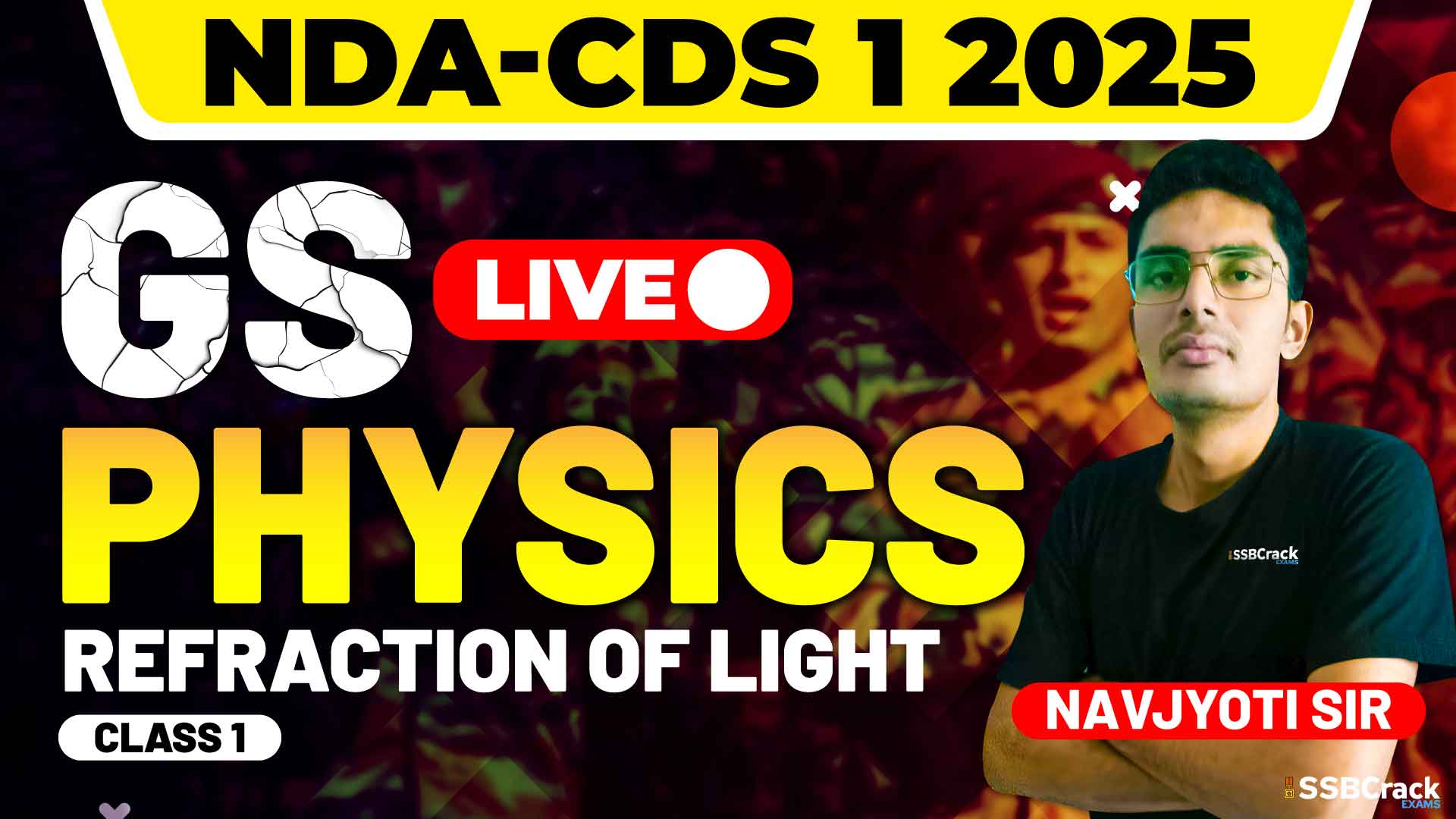Physics plays a pivotal role in the preparation for competitive exams like the National Defence Academy and Naval Academy (NDA-NA) Exam – Paper II – General Ability Test (GAT) and the General Knowledge (GK) Paper of the Combined Defence Services (CDS) Exam. One of the most intriguing and application-oriented topics in Physics is Refraction of Light. A recent class was dedicated to this concept, exploring its principles and real-world applications to prepare students for the Physics section of these exams.
This blog delves into the class details, strategies to prepare for this topic, and the relevance of Refraction of Light in the context of the NDA-NA and CDS exams.
Key Highlights of the Class
1. Introduction to Refraction of Light
The class began with an introduction to Refraction of Light, where the change in the direction of light as it passes from one medium to another was explained. Students learned about:
- The fundamental nature of refraction.
- The role of the speed of light in different mediums.
- Real-life instances, like the bending of a stick partially immersed in water.
This foundation set the stage for understanding the associated phenomena and principles.
2. Laws of Refraction
The class proceeded to cover the Laws of Refraction, focusing on their consistency and universality. Students were encouraged to think critically about how these laws apply in daily life, such as light passing through a glass window or water droplet.
3. Refractive Index
The concept of Refractive Index was discussed in depth. This sub-topic emphasized the comparative speed of light in different mediums and how the refractive index determines the bending of light. The discussion included real-world examples like:
- Diamonds and their brilliance due to high refractive index.
- Glass and water as common refractive mediums.
4. Lenses: Convex and Concave
Lenses formed a significant part of the session. Students explored the behavior of light when passing through convex and concave lenses and their applications, including:
- Magnifying glasses (convex lens).
- Spectacles for correcting vision (both convex and concave lenses).
Practical questions helped students relate lens properties to image formation and magnification.
5. Atmospheric Refraction and Natural Phenomena
The class touched on atmospheric refraction and its fascinating effects, such as:
- Twinkling of stars.
- Advanced Sunrise and Delayed Sunset.
These examples linked theoretical knowledge to observable natural phenomena, making the topic engaging.
6. Total Internal Reflection and Applications
Total Internal Reflection (TIR) was another highlight of the session. Students learned about:
- The critical angle and conditions necessary for TIR.
- Applications like:
- Sparkling of diamonds: Explained through light’s multiple reflections within the diamond.
- Optical fibers: Demonstrated as a revolutionary technology enabling fast data transmission.
- Mirage: A natural phenomenon in deserts, showcasing the bending of light in layers of air with different densities.
Strategies to Prepare Refraction of Light for NDA-NA and CDS Exams
Refraction of Light is a topic that combines theoretical concepts with practical applications. Preparing for this topic requires a balanced approach.
1. Understand the Core Concepts
Start by building a strong foundation in the basics:
- What is refraction?
- How do the laws of refraction work?
- What is refractive index, and why does it matter?
Relate these concepts to everyday phenomena for better understanding.
2. Focus on Applications
Many questions in competitive exams revolve around real-world applications of refraction. Pay special attention to:
- Natural occurrences like twinkling stars and mirages.
- Practical uses of TIR in technologies like optical fibers.
Knowing the why behind these applications will make solving conceptual questions easier.
3. Study Lenses in Detail
Convex and concave lenses are frequently tested in exams. Learn their properties, including:
- The types of images they form.
- Their uses in devices like cameras, telescopes, and microscopes.
Practice solving problems involving lenses, focusing on real-world examples.
4. Practice Drawing Diagrams
Visualization is key in understanding refraction and TIR. Practice drawing neat, labeled ray diagrams to depict:
- Refraction through a glass slab.
- Image formation by lenses.
- Total internal reflection.
These diagrams help clarify concepts and can be used for quick revision before the exam.
5. Solve Previous Years’ Questions
Go through past NDA-NA and CDS exam papers to familiarize yourself with the types of questions asked. Focus on:
- Application-based MCQs.
- Conceptual questions about natural phenomena.
This practice will help you identify common patterns and important sub-topics.
6. Use Mnemonics for Retention
For memorizing conditions or laws, use mnemonics or short phrases to retain information quickly.
7. Revise Regularly
Make a habit of revisiting this topic periodically. Use concise notes that highlight the key concepts, definitions, and applications for quick revision.
Conclusion
The recent class on Refraction of Light provided a comprehensive overview of this important topic, focusing on its principles, applications, and real-world phenomena. By practicing questions and engaging with real-life examples, students can develop a thorough understanding of the subject.
To excel in this topic, aspirants should focus on building conceptual clarity, mastering ray diagrams, and practicing application-based questions. Consistent effort, along with a strategic approach, can make Refraction of Light one of the most scoring sections in the Physics syllabus for NDA-NA and CDS exams.
With proper preparation, this topic becomes not just an academic requirement but a fascinating insight into the wonders of light. So, stay consistent, keep revising, and approach the exams with confidence.



















